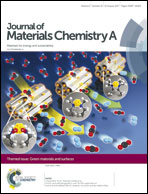Nanofiltration membranes with cellulose nanocrystals as an interlayer for unprecedented performance†
Abstract
Nanofiltration membranes are of great interest in brackish water desalination and drinking water purification. Improving the permeation and separation performance remains a big challenge in advanced nanofiltration membranes. Herein, we report triple-layered composite nanofiltration membranes constructed by the interfacial polymerization of diamine and acyl chloride on a cellulose nanocrystal interlayer supported by a microporous substrate. The cellulose nano-crystal interlayer plays a crucial role in the polyamide skin layer formation and the following nanofiltration process. It can store aqueous diamine monomers and slow down the interfacial polymerization for a relatively low cross-linking degree of the skin layer. This hydrophilic interlayer also facilitates water permeation through a “dragging effect”. The constructed membranes exhibit an ultra-high permeation flux up to 204 L m−2 h−1 under 0.6 MPa with a Na2SO4 rejection above 97%, which is the highest reported result to our knowledge. The ultra-high water permeation flux enables nanofiltration at low operating pressure, making it an energy-saving process. Moreover, the low cross-linking degree of the skin layer results in a high monovalent/divalent ion separation ratio.

- This article is part of the themed collection: Green Materials and Surfaces


 Please wait while we load your content...
Please wait while we load your content...